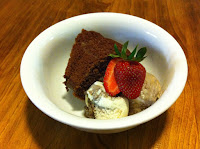Today in our Food Science lab we cooked an amazing vegetarian chilli cornbread casserole to demonstrate the qualities of cereals and starches and I just wanted to share :-) These students are our future dietitians, nutritionists and home economics teachers. As well as this lovely dish, we prepared a million different types of starch pastes and tested their various viscosities and characteristics- they're not quite so yummy to eat though......
Here's the recipe for your cooking pleasure:
Vegetarian Chilli Cornbread Casserole
NB. Preheat oven to 220°C
The chilli
Ingredients (serves 4)
80ml (1/3 cup) olive oil
1 large onion, peeled, finely chopped
1 small red chilli, seeded, chopped
1/2 red capsicum, chopped
1/4 tsp chilli flakes
1/2 tsp ground cinnamon
1 tsp ground cumin
1 tsp dried thyme
2-3 garlic cloves, crushed
420g can mixed beans, drained, rinsed
420g can lentils, drained, rinsed
425g can diced tomatoes
1 tbsn tomato paste
Method
1. Place 2tbsn of oil in a large saucepan over medium heat. Add the onion, fresh chilli & capsicum & cook until softened. Add the chilli flakes, cinnamon, cumin & thyme & cook for a further minute.
2. Reduce heat to low & add the garlic, beans, lentils, tomatoes, tomato paste & remaining oil.
3. Cover & simmer for 15 minutes, stirring occasionally. Remove lid & cook for a further 5 minutes or until thickened.
Source: delicious. - March 2003, p.85; Recipe by Valli Little
The cornbread
2 Tbs (¼ stick) butter
½ cup corn meal
1 tsp baking powder
½ tsp baking soda
½ tsp salt
1 egg
½ cup milk
½ cup flour (use gluten free flour)
1. Melt, then cool butter.
2. Whisk butter, egg, & milk together.
3. Combine corn meal, flour, & salt, then add baking powder & baking soda.
4. Stir in liquid mixture (butter, egg & milk).
5. Set aside & go back to chilli recipe above.
The Casserole
1. Spray a 23 x 30cm baking pan with cooking spray.
2. Put entire chilli recipe in baking pan & smooth surface.
3. Spoon cornbread mixture over chilli mixture & smooth with a large spoon.
4. Bake about 20min, or until cornbread pulls away from the sides of the pan.














